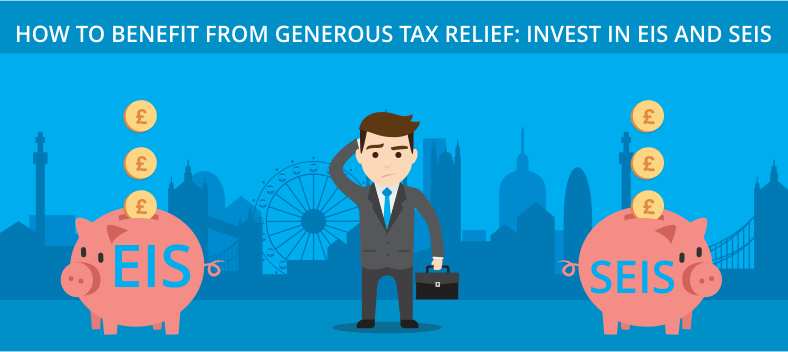How to Benefit from Generous Tax Relief: Invest in EIS and SEIS
The Enterprise Investment and Seed Enterprise Investment Schemes are similar, except that SEIS is specifically for investors who are willing to invest in seed companies where the risk is greater. Both SEIS and EIS are tax efficient ways to invest in small companies – from £100,000 to £1,000,000 per person per year in qualifying companies.

| EIS Overview | SEIS Overview |
|---|---|
| Maximum annual investment of £1 million | Maximum annual investment of £100,000 |
| EIS helps companies that need capital but are not listed on the stock exchange | SEIS helps smaller (seed), higher-risk companies raise finance by offering tax relief on new shares in companies that qualify |
| Company must be registered in the UK; company must have fewer than 250 full-time employees | Company must be registered in the UK; be newly incorporated and not have been trading for more than two years; have fewer than 25 full-time employees |
| Company must have assets of less than £15 million | Company must have assets of less than £200,000 |
| Company must be in an approved sector (i.e. property companies, hotels and finance or investment companies are not approved) | Company must be in an approved sector (i.e. property companies and finance or investment companies are not approved) |
| People connected with the company are not eligible for income tax relief on their shares (connections defined "as through financial interest or employment") | People connected with the company are not eligible for income tax relief on their shares (connections defined "as through financial interest or employment") |
| An investor in EIS can be a director in the company provided they meet certain conditions (i.e. a Business Angel who receives no remuneration from the company) | An investor in SEIS can be a director in the company provided they meet certain conditions (i.e. a Business Angel who receives no remuneration from the company) |
| EIS Benefits | SEIS Benefits |
|---|---|
| An individual can invest up to £1 million and a married couple can invest up to £2 million in a tax year and both are eligible for tax relief | An individual can invest up to £100,000 and a married couple can invest up to £200,000 in a tax year and both are eligible for tax relief |
| Generous tax relief of 30% | Even more generous tax relief of 50% |
| Capital Gains tax relief on disposal of the shares after three years | Capital Gains tax relief on disposal of the shares after three years |
| A "carry back" facility means investments can be applied to the preceding tax year; it may be possible to carry back a further year with EIS but strict guidelines apply and do need checking | A "carry back" facility means investments can be applied to the preceding tax year |
| Investments are exempt from inheritance tax after two years of holding the investment | Investments are exempt from inheritance tax after two years of holding the investment |
| Losses can be set against CGT or income tax in the year of disposal. | Losses can be set against CGT or income tax in the year of disposal |
| The CGT tax due on any asset can be deferred by reinvesting in shares in another EIS-qualifying company in a period beginning one year before and three years after the disposal of the original asset | The CGT tax due on any asset can be deferred by reinvesting in shares in another SEIS-qualifying company in the same tax year up to £100,000. |
Three Examples EIS
You invest £10,000 and you are in the 45% tax bracket
The company does well and doubles its value. You hold the shares for three years
Investment = £10,000
Income Tax relief = £3,000 (30% reduction in your income tax bill)
Capital Gains Tax = £0
Gain: £13,000 (£10,000 profit from the sale plus £3,000 income tax relief)
The company value stays the same
Investment = £10,000
Income Tax relief = £3,000 (30% reduction in your income tax bill)
Share sales = £10,000
Gain: = £3,000 (from the income tax relief)
The company closes
Investment = £10,000
Income Tax relief = £3,000 (30% reduction in your income tax bill)
At risk capital = £7,000
Loss relief = £3,150 (45% of at-risk capital)
Loss: = £3,850 (£10,000 – £3,000 + £3,150)
Three Examples SEIS
You invest £10,000 and you are in the 45% tax bracket
The company does well and doubles in value. You hold the shares for three years
Investment = £10,000
Income Tax Relief = £5,000 (50% reduction in your income tax bill)
Profit from sale = £10,000
Capital Gains Tax = £0
Gain: = £15,000
The company value stays the same
Investment = £10,000
Profit from sale = £0
Gain = £5,000 (50% reduction in your income tax bill)
The company closes
Investment = £10,000
Income Tax Relief = £5,000 (50% reduction in your income tax bill)
At risk capital = £5,000
Loss relief = £2,250 (45% of at-risk capital)
Loss = £2,750 (£10,000 – £5,000 + £2,250)
To invest or not to invest?
FIRST OF ALL, VERY IMPORTANT
Check that any business you are interested in investing in has SEIS "advanced assurance": this is a certificate emailed to the investor by HMRC confirming that investors will benefit from SEIS.
Some say that you should never gamble what you cannot afford to loose and the same is true of investments. These are very attractive government initiatives to boost small business and it makes very good tax-planning sense to invest and reap the tax benefits – not only in the tax year in which you invest but the previous tax year also – and with EIS possibly even the year before that. If you want high risk and greater tax relief go for SEIS, if you want lower risk and a lower tax relief, then go for EIS.
Additional paperwork
There will be additional paperwork: the investor can only claim the tax relief once the company in which they have invested sends through an EIS3 form. Claims are made through the Self-Assessment tax return for the tax year in which the shares were issued. You can still put in a claim for EIS and SEIS tax relief: you have five years, as of the 31 January, following the tax year in which the investment was made.
Talk to DNS
We can offer advice and guidance on investing in EIS or SEIS and look after the additional paperwork. Talk to your Account Manager if this strikes you as something you would be interested in investigating further.
Any questions? Schedule a call with one of our experts.








